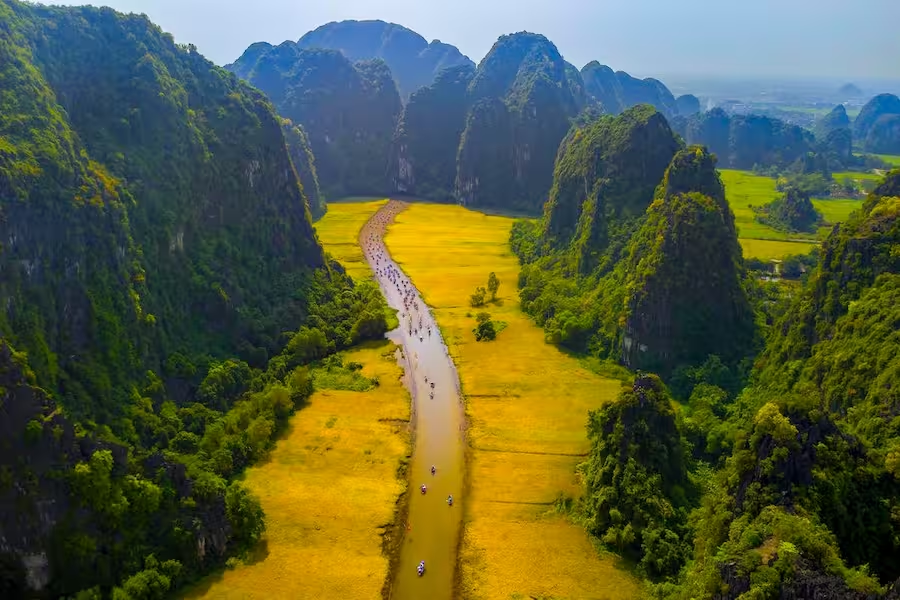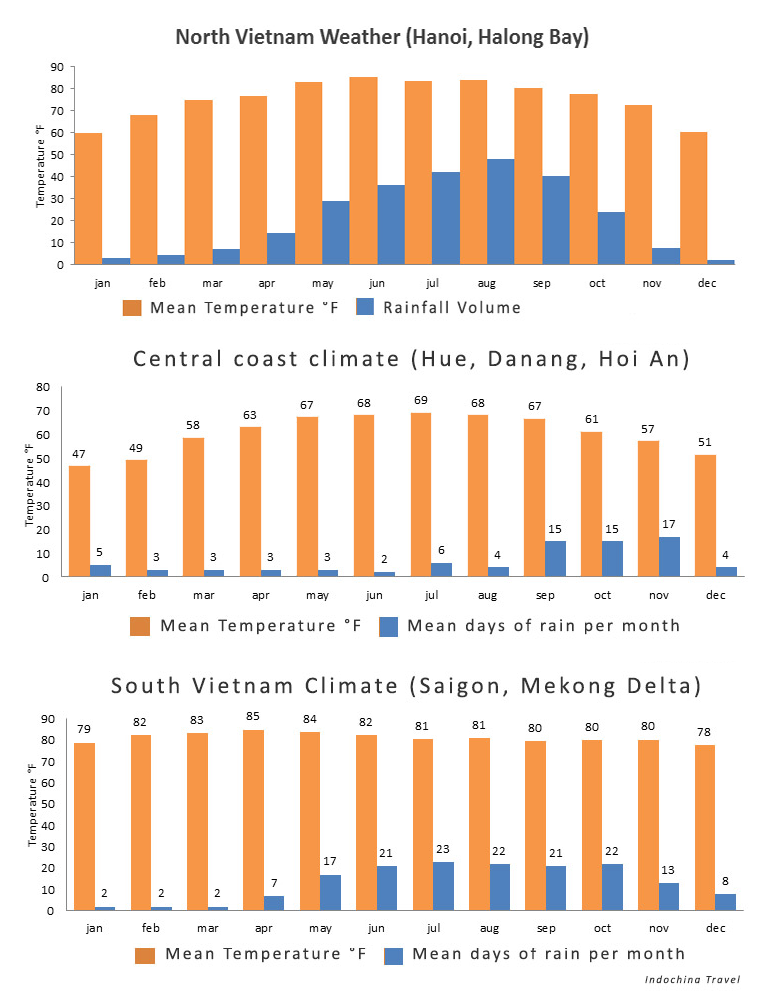When planning tours and crafting travel packages to Vietnam, few factors are as crucial as understanding Vietnam weather. As a country that stretches over 1,600 kilometers from north to south, Vietnam boasts a complex climatic profile influenced by monsoon patterns, altitude, and geography. For B2B travel professionals—tour operators, travel agents, and DMCs—accurate knowledge of Vietnam’s weather patterns isn’t just helpful; it’s essential for ensuring itinerary success, managing client expectations, and optimizing seasonal bookings.
At Tonkin Legends, we specialize in designing custom experiences that align with Vietnam’s seasonal nuances. That means every itinerary we build is backed by deep weather insights and local expertise, helping partners deliver seamless, well-timed journeys across this diverse destination.
Northern Vietnam: Four Distinct Seasons and Temperature Swings
Northern Vietnam, including Hanoi, Halong Bay, Ninh Binh, and the mountainous regions like Sapa and Ha Giang, experiences four distinct seasons. Winters are typically cool and dry, stretching from November through February. During this time, average temperatures hover between 12°C to 20°C, though mountainous areas can dip below 10°C, sometimes accompanied by mist or even frost.
Spring emerges from March to April, characterized by rising humidity and occasional light drizzle. This transitionary period sees blossoming flowers and verdant landscapes, making it ideal for scenic tours and cultural immersion.
The summer months, from May to August, are hot and humid, with daytime temperatures often exceeding 35°C. Thunderstorms are frequent, especially in the late afternoon, and heavy rains can sometimes disrupt transport in mountainous regions. Autumn, running from September to October, is considered one of the most pleasant seasons in the North, with clear skies, mild temperatures, and reduced rainfall.
From a business perspective, Vietnam weather in the north directly influences trekking tours, Halong Bay cruises, and rural village experiences. Tour planners should consider late autumn or spring for such activities, when the conditions are optimal but crowds remain manageable.
Central Vietnam: Weather Extremes and Seasonal Challenges
Central Vietnam, which includes Hue, Danang, Hoi An, and Phong Nha, presents a more challenging weather profile for itinerary planning. This region is known for its susceptibility to typhoons, especially from September to November, which can cause travel disruptions due to flooding or strong winds.
The dry season generally lasts from January through August, though temperatures can spike significantly during the summer. Cities like Hue and Hoi An often experience temperatures above 38°C in June and July. The influence of the Truong Son mountain range means that Central Vietnam sometimes escapes the extreme cold or rain seen in the North or South, but this same geography also concentrates weather events, intensifying heatwaves or rainfall.
Given this complexity, B2B travel businesses should plan beach holidays and cultural excursions in Central Vietnam for the dry months, particularly from February to May. The tail-end of the year requires caution due to Vietnam weather hazards like tropical storms. Communication with local partners and suppliers is key during this period to avoid unexpected itinerary changes.
Southern Vietnam: A Tropical Climate with Two Clear Seasons
Southern Vietnam, which encompasses Ho Chi Minh City, the Mekong Delta, and beach destinations like Phu Quoc and Con Dao, experiences a tropical monsoon climate with just two seasons: wet and dry.
The dry season runs from December to April and is widely regarded as the best time to visit this region. Temperatures are consistently warm, averaging between 25°C to 35°C, and humidity levels are relatively low compared to the rest of the year. This makes it an ideal time for outdoor tours, river cruises, and beach holidays.
From May to November, the rainy season brings short but intense downpours, typically in the afternoon or evening. While travel is still possible and often enjoyable, these months require more flexibility in planning. Importantly, heavy rains do not usually last all day, allowing most activities to proceed with minor adjustments.
For B2B operators, understanding this weather dynamic is vital when marketing Southern Vietnam. The dry season is prime time for group tours and FIT itineraries, while the rainy season is suitable for off-peak promotions or value-focused packages, particularly when targeting long-stay or adventure travelers.
Nationwide Climate Considerations for Itinerary Planning
The variability of Vietnam weather means that there is technically no bad time to visit the country—only different regions that shine in different months. For multi-region tours, staggered climate conditions require strategic routing. For instance, a north-to-south itinerary in February allows travelers to enjoy the cool charm of Hanoi and the sun-drenched beaches of Phu Quoc in a single journey.
Vietnam weather also plays a direct role in festival timing and agricultural cycles, which in turn shape cultural experiences. The Tet Lunar New Year, usually occurring in late January or early February, coincides with the dry season in most regions and is a popular, albeit busy, time for inbound tourism. The rice harvest season in the northern highlands, typically in September and October, offers exceptional photo opportunities and immersive rural experiences.
Professional travel businesses should maintain updated seasonal calendars and climate forecasts, not just for operational efficiency but also as a value-added service for clients. Recommending the right time to travel is a key driver of client satisfaction and brand credibility.
Weather-Based Sales & Marketing Opportunities
From a sales standpoint, Vietnam weather can be used as a powerful marketing lever. Highlighting ideal travel months for specific regions allows businesses to stagger promotions and maintain year-round engagement. For instance, while Northern Europe freezes in December, Southern Vietnam’s dry season offers a compelling warm-weather escape. Meanwhile, savvy travel agents can push Central Vietnam tours during the spring shoulder season, when flight and hotel prices are lower but weather remains favorable.
Understanding local climate data also helps in managing risks. Having backup plans for weather-related disruptions, like alternate indoor activities or flexible refund policies, adds professionalism and peace of mind for clients. In a competitive B2B travel landscape, this kind of preparedness sets reputable operators apart from the rest.
Moreover, Vietnam’s evolving climate situation due to global warming is beginning to affect predictability. Partnering with local weather services and investing in real-time data tools can improve on-the-ground accuracy, especially during peak typhoon periods. For multi-destination DMCs, aligning regional weather insights into product development is no longer optional—it’s strategic necessity.
Building Climate-Savvy Vietnam Itineraries
In the world of B2B travel, itinerary success is determined not just by the places included but by when and how they are visited. Vietnam weather, with its regional contrasts and seasonal quirks, should be at the core of every travel professional’s planning toolkit.
By leveraging weather patterns strategically, tour operators and travel agents can design seamless experiences that align with both client expectations and climatic realities. Whether it’s timing Halong Bay cruises for autumn skies, avoiding typhoon season in Central Vietnam, or capitalizing on the Southern coast’s year-end sunshine, mastery of Vietnam’s weather is an underrated competitive advantage.
In conclusion, for travel professionals aiming to deliver excellence in Vietnamese inbound tourism, understanding Vietnam weather is not just about checking forecasts—it’s about mastering timing, optimizing routes, and anticipating needs. It is a tool for differentiation, service quality, and ultimately, sustainable business growth.



Comment (0)